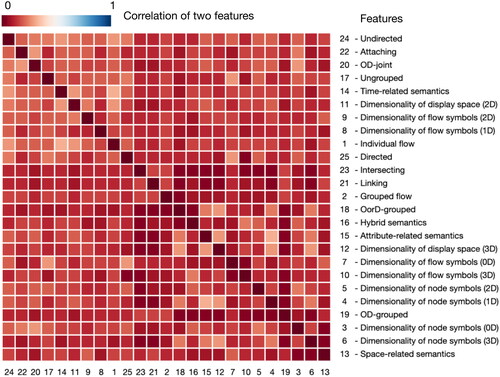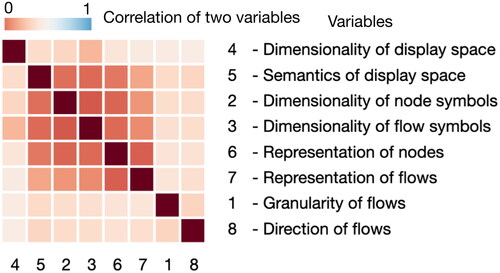Figures & data
Figure 1. The OD matrix: (a) An example of an OD data matrix, with regional migration data in 2018, Iceland (Iceland Citation2023). The numbers represent migrating people. (b) OD data components: connection (true or false); spatial (description of trajectory); time (duration); attribute (qualitative and/or quantitative). (c) OD matrix reading levels (highlighted cells): elementary (cell to cell), intermediate (cell to row or column); overall (all to all). Schematic diagrams on the top show examples of three reading levels. The matrix at the bottom shows the lower right section from the OD matrix in (a).
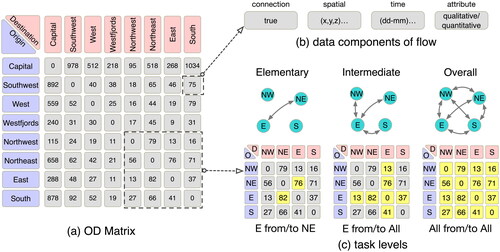
Table 1. The classification scheme and the structure of the section.
Figure 2. Appling different semantics to the third dimension, two flows (from A to B, and from A to C) are visualized with example data. (a) Application of space-related semantics to the third dimension. Lines are imitations of plane trajectories. (b) Application of time-related semantics to the third dimension. It is an example of space-time cube. (c) Application of attribute-related semantics to the third dimension, where the third dimension represents the attribute component. (d) Application of attribute-related semantics to the third dimension, where the third dimension represents connection.
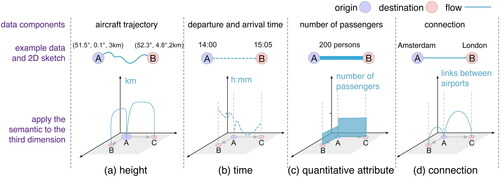
Figure 3. Representation of nodes. The five columns show five categories of node representations. The first row indicates how can the five categories are conceptually transformed. The second row are sketches of four flows between two nodes. The third row shows the context of each category. The last row shows examples of each category.
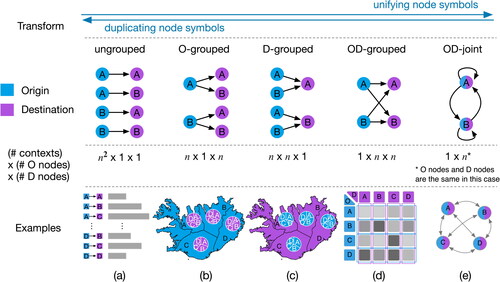
Figure 4. Representation of flows: linking, attaching, and intersecting. In linking, the relation between the origin symbols and the destination symbols is disjoint. In attaching, the relation between the origin symbols and the destination symbols is adjacent or touching. In intersecting, the relation between the origin symbols and the destination symbols is overlap or containment.
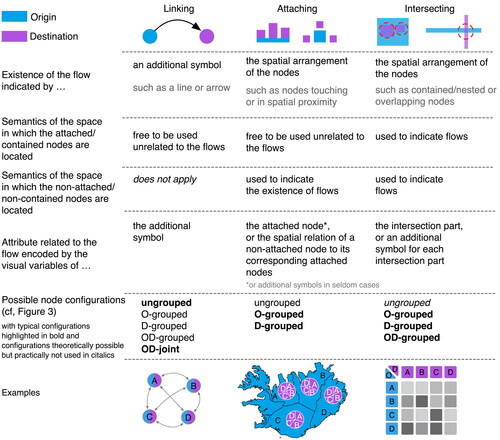
Figure 6. Examples of the identification of nodes. In the two visualizations (Vis-1 and Vis-2), nodes are represented by several node symbols. Node symbols in the two visualizations can be identified in several ways. (a) Positioning: Nodes can be positioned close to each other, in corresponding positions in each visualization, or by other rules. (b) Drawing lines between node symbols, indicating that they are representing the same node. These lines need to differ from flow symbols. (c) Color-coding the node symbols. (d) Brushing: Interaction can be applied to node identification. When selecting the node symbol in Vis-1, the corresponding symbol in Vis-2 will be highlighted. (e) Labelling: Labels are used to identify nodes directly.

Figure 7. Three possibilities of flow representation when relating two OD visualizations. (a) Flow symbols are connecting origins and destinations within one visualization. (b) Flow symbols are connecting origins and destinations across two different visualizations. (c) Combination of (a) and (b).

Figure 8. Relating two visualizations by nesting. There are two visualizations (Vis-1 and Vis-2). Multiple Vis-1 are nested into Vis-2, which are positioned where the node symbols in Vis-2 are located.

Figure 9. Reordered distance matrix for 54 OD visualization examples. The 54 × 54 matrix represents distances among 54 OD visualizations. It is reordered by the single-linkage clustering method. Certain visualizations are more similar than others, and these are grouped in a blue rectangle.
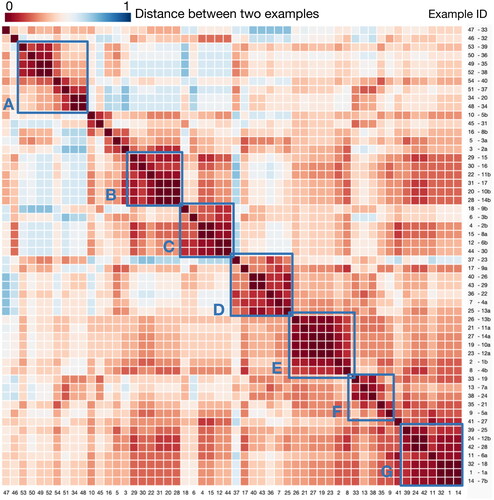
Table 2. Classifying existing OD visualization examples in the literature.
Data and codes availability statement
The data and codes are available on figshare.com with the link: https://doi.org/10.6084/m9.figshare.21176320.v3. The data is a matrix created according to in this manuscript. The code computes the three functions in Section 5 correspondingly.


